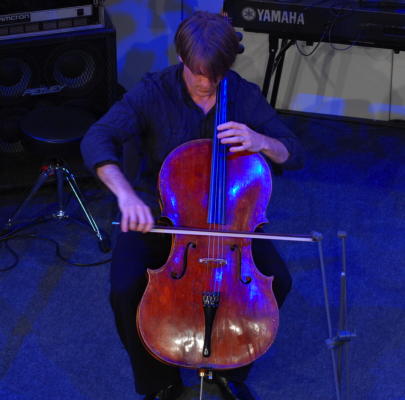|
<<< << -- 3 -- Tess Crebbin HOPE BREAKING THROUGH -- >> >>>

Gerhardt may not speak about his emotions surrounding his recent loss, but at Munich he lets his cello speak for him -- eyes closed and oblivious to his surroundings, he is but a passenger guiding the bow in what proves to be a deeply emotional journey through hope, loss and final triumph, as can only be musically expressed by Bach's writing for an instrument that spans the entire range of the human voice.
And his cello can certainly speak, for it has a rather unique sound. It is voluminous, resonant and displays a superior combination of clear tonal quality and very responsive reaction. It is probably the best instrument to illustrate the close relationship between the two leading Venetian makers, Gofriller and Montagnana. The cello has a certificate by Charles Beare, in whose opinion it is a Matteo Gofriller (1659-1742) dating from between 1700 and 1710. As Beare points out, it is characteristic of the maker's work but, having said that, there are some aspects leaning on Montagnana (1686-1750), Gofriller's student.

A closer view of Alban Gerhardt's Gofriller cello. Photo © 2008 Frank Langbein
|
Here, the master may well have taken a closer look at his student's work, for not only does Gerhardt's cello unite some of the typical Gofriller attributes with some of those of Montagnana (Gerhardt, speaking of the middle bout: 'It is the only Gofriller I have ever seen that does not have the characteristically slim hips carved out') but there is also the sound to be considered. The cello is somewhat wider at the lower body, for instance. In this larger than usual instrument, as many critics have already noted, there is considerable strength and color in the low registers -- which come with enormous substance and clarity to them, especially when played with a French bridge as Gerhardt does -- more so than in the traditional Gofriller instruments. While the instrument does not have the characteristic 'Montagnana voice', it does seem like a rare combination of the best aspects of what are arguably two of the finest cello makers ever, and certainly the finest of the Venetian school.
Gerhardt, incidentally, couldn't care less. 'It works, that's all that matters to me,' he says. 'You play it, it gives you beautiful sound, and it is a good instrument that performs obediently. Who makes it is not so important to me, I care primarily about the sound.'
That said, he adds in the next sentence that he prefers Stradivari above all others. 'I played a Strad once,' he said, 'and also a Montagnana and now, of course, a Gofriller. In comparison, the Gofriller and the Montagnana are very reliable, delivering good performance if you know how to use them. The Strad is somewhat temperamental -- it doesn't just offer you the best sound on a silver platter, it challenges you to find it but if you know how to play a Strad, then, in my opinion, it is just about the best thing that can happen to you as a cellist.'
Continue >>
Copyright © 14 June 2008
Tess Crebbin, Munich, Germany

|

